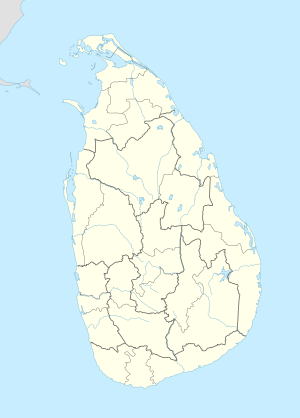
The Special Task Force (STF) (Sinhala: විශේෂ කාර්ය බලකාය Visesha Karya Balakaya; Tamil: சிறப்பு அதிரடிப் படை) is an elite police tactical unit of the Sri Lanka Police specialising in clandestine and covert operations, combat and patrolling in urban areas, combat search and rescue, counterinsurgency and counterterrorism operations, crowd control, executive protection, forward observer, hostage rescue, indirect fire, irregular warfare, jungle and mountain warfare, parachuting, psychological warfare, search and rescue people who are in distress or imminent danger from disaster. serving high-risk arrest and search warrants, special reconnaissance, support military operations, tactical emergency medical, tracking, and unconventional tactics. It was formed in 1983 not as a military force, but rather as a highly specialised armed police unit.
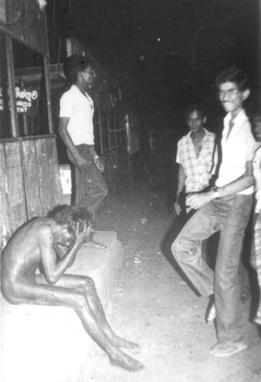
Black July was an anti-Tamil pogrom that occurred in Sri Lanka during July 1983. The pogrom was premeditated, and was finally triggered by a deadly ambush on 23 July 1983, which caused the death of 13 Sri Lanka Army soldiers, by the Tamil militant group Liberation Tigers of Tamil Eelam (LTTE). Although initially orchestrated by members of the ruling UNP, the pogrom soon escalated into mass violence with significant public participation.
The Pottuvil Massacre was the killing of 10 Muslim labourers who had gone to repair the bund of Rattal Tank in Pottuvil in the southern part of the Ampara District on 17 September 2006. The victims were all men aged between 18–35 whose bodies were found hacked to death the next morning. The massacre was widely believed to have been carried out by the Special Task Force (STF).
The Anuradhapura massacre occurred in Sri Lanka in 1985 and was carried out by the Liberation Tigers of Tamil Eelam. This was the largest massacre of Sinhalese civilians by the LTTE to date; it was also the first major operation carried out by the LTTE outside a Tamil majority area. Initially, EROS claimed responsibility for the massacre, but it later retracted the statement, and joined the PLOTE in denouncing the incident. The groups later accused the LTTE for the attack. Since then, no Tamil militant group has admitted to committing the massacre. However, state intelligence discovered that the operation was ordered by the LTTE's leader Velupillai Prabhakaran. He assigned the massacre to the LTTE Mannar commander Victor and it was executed by Victor's subordinate Anthony Kaththiar. The LTTE claimed the attack was in revenge of the 1985 Valvettiturai massacre, where the Sri Lanka Army killed 70 Tamil civilians in Prabhakaran's hometown.
The Kalmunai massacre refers to a series of mass killings that occurred in June 1990 in Kalmunai, a municipality within the Ampara District of Sri Lanka's Eastern Province. The massacre of Tamil civilians was allegedly carried out by the Sri Lankan Army in retaliation for an earlier massacre of Sri Lankan police officers. The University Teachers for Human Rights, a human rights organization, put the number of dead in the second massacre at 250, while a local Member of Parliament claimed that at least 160 people were killed.
Eelam War I is the name given to the initial phase of the armed conflict between the government of Sri Lanka and the LTTE.

The Eastern Theatre of Eelam War IV started in the Eastern province of Sri Lanka on July 21, 2006 when the LTTE cut off the water supply to rice fields in eastern Trincomalee district. The government claimed total control of the Eastern province after capturing Thoppigala on July 11, 2007, after nearly a year of fighting. Major battles took place at Sampoor, Vakarai, Kanchikudicharu, Kokkadichloai and Thoppigala. Military and civilian deaths were relatively low on both sides. Government forces captured much military hardware from the LTTE during the conflict. The civilians managed to flee the combat zones, and this reduced civilian casualties, while swelling the number of internally displaced people (IDP). The world health organization (WHO) estimated ~200,300 IDPs, and claims that significant progress occurred in resettling them. The LTTE vowed to attack Sri Lanka's military and economic targets across the country to retaliate for the capture of the Eastern province from them. This was stated by the leader of the LTTE's political wing, S.P. Thamilchelvan, in a statement to Associated Press on July 12, 2007.
Karaitivu is a coastal village situated in the Eastern Coast of Sri Lanka about 30 miles (44 km) south of Batticaloa and is next to Kalmunai town. This is one of the oldest surviving village settlements in the Ampara District.

Kalmunai is a city located in the Ampara District of Eastern Province, Sri Lanka.

Aboobucker Mohamed Abdul Azeez was a Ceylonese civil servant, educator, social worker and member of the Senate of Ceylon.

The 1956 anti-Tamil pogrom, also known as the Gal Oya riots, was the first organised pogrom against Sri Lankan Tamils in the Dominion of Ceylon. It began with anti-Tamil rioting in Colombo, followed by anti-Sinhalese rioting in Batticaloa. The worst of the violence took place in the Gal Oya valley, where local majority Sinhalese colonists and employees of the Gal Oya Development Board commandeered government vehicles, dynamite and weapons and massacred minority Tamils. It is estimated that over 150 people, mostly Tamils, had died during the violence. The police and army were eventually able to bring the situation under control.
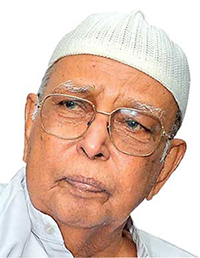
Mohamed Haniffa Mohamed was a Sri Lankan politician. Mohamed served as the 14th Speaker of the Parliament of Sri Lanka as well as being a former member of Parliament and government minister. Mohamed was the first Sri Lankan Moor to hold office as Mayor of Colombo from 1960 to 1962
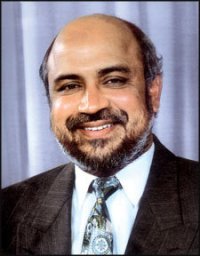
Mohammed Hussain Mohammed Ashraff was a Sri Lankan lawyer, politician, government minister and founder/leader of the Sri Lanka Muslim Congress.
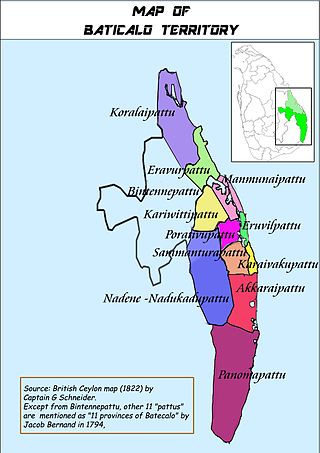
Batticaloa region in colonial records was the ancient region of Tamil settlements in Sri Lanka. The foremost record of this region can be seen in Portuguese and Dutch historical documents along with local inscriptions such as Sammanthurai Copper epigraphs written in 1683 CE which also mentions Mattakkalappu Desam. Although the region was bifuricated into districts of Batticaloa and Ampara Districts, the amended term "Batti-Ampara Districts" as well as “Keezhakarai” can still be seen in the Tamil print media of Sri Lanka.
Terrorism in Sri Lanka has been a highly destructive phenomenon during the periods of the Sri Lankan Civil War (1983–2009) and the first and second JVP insurrections. A common definition of terrorism is the systematic use or threatened use of violence to intimidate a population or government for political, religious, or ideological goals. Sri Lanka is a country that has experienced some of the worst known acts of modern terrorism, such as suicide bombings, massacres of civilians and assassination of political and social leaders, that posed a significant threat to the society, economy and development of the country. The Prevention of Terrorism Act of 1978 is the legislation, that provides the powers to law enforcement officers to deal with issues related to terrorism in Sri Lanka. It was first enacted as a temporary law in 1979 under the presidency of J. R. Jayewardene, and later made permanent in 1982.
The Sri Lankan anti-Muslim riots were a series of religious riots targeting Muslims that began in the town of Ampara located in Sri Lanka on 26 February 2018, spreading to the Kandy District from March 2 until its end on March 10, 2018.

The 1987 Eastern Province massacres were a series of massacres of the Sinhalese population in the Eastern Province of Sri Lanka by Tamil mobs and Liberation Tigers of Tamil Eelam (LTTE) during the Sri Lankan Civil War. Though they began spontaneously, they became more organized, with the LTTE leading the violence. Over 200 Sinhalese were killed by mob and militant violence, and over 20,000 fled the Eastern Province. The violence has been described as having had the appearance of a pogrom.
The Veeramunai massacres refers to the mass killing and disappearances of over 250 Tamil civilians by Sri Lankan security forces and Muslim home guards in 1990.
